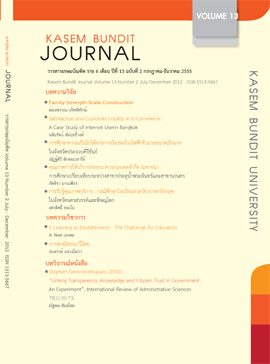คุณภาพการให้บริการของธนาคารกรุงเทพ จำกัด (มหาชน) : การศึกษาเปรียบเทียบระหว่างสาขาประตูน้ำพระอินทร์และสาขานวนคร
Keywords:
คุณภาพการให้บริการ, ธนาคารกรุงเทพ จำกัด (มหาชน), Service quality, Bangkok Bank Public Company LimitedAbstract
การวิจัยครั้งนี้มีวัตถุประสงค์เพื่อศึกษาระดับคุณภาพการให้บริการและเปรียบเทียบคุณภาพการให้บริการของธนาคารกรุงเทพ จำกัด (มหาชน) จำแนกตามปัจจัยส่วนบุคคล และจำแนกตามสาขาที่ให้บริการ ประชากร คือ ลูกค้าที่มาใช้บริการธนาคารกรุงเทพ จำกัด (มหาชน) สาขานวนคร และสาขาประตูน้ำพระอินทร์รวม 1,047,500 คน การเลือกกลุ่มตัวอย่าง จำนวน 400 คนใช้วิธีกลุ่มตัวอย่างอุบัติการณ์ เครื่องมือที่ใช้ในการเก็บรวบรวมข้อมูลคือ แบบสอบถามเกี่ยวกับปัจจัยส่วนบุคคล และเกี่ยวกับคุณภาพการให้บริการ ส่วนสถิติที่ใช้ในการวิเคราะห์ข้อมูล ได้แก่ ค่าร้อยละ ค่าเฉลี่ย และค่าเบี่ยงเบนมาตรฐาน สถิติที่ใช้ทดสอบสมมติฐาน ได้แก่ ค่าสถิติทดสอบที ค่าความแปรปรวนทางเดียว เมื่อพบความแตกต่างจะทำการเปรียบเทียบรายคู่โดยวิธีของเชฟเฟ่ (Scheffé test) โดยกำหนดนัยสำคัญทางสถิติไว้ที่ระดับ .05 และ .01 ผลการศึกษาพบว่า กลุ่มตัวอย่างส่วนใหญ่เป็นเพศหญิง มีอายุ 25 - 35 ปี มีการศึกษาระดับมัธยมศึกษาตอนปลาย/ปวช. อาชีพพนักงานบริษัท/หน่วยงานเอกชน และรายได้เฉลี่ยต่อเดือน 10,001 - 25,000 บาท
คุณภาพการให้บริการของธนาคารกรุงเทพ จำกัด (มหาชน) สาขาประตูน้ำพระอินทร์ และสาขานวนครใน ภาพรวมอยู่ในระดับสูง เมื่อพิจารณาตามสาขา พบว่า สาขาประตูน้ำพระอินทร์ ภาพรวม อยู่ในระดับสูง โดยมีความคิดเห็น ด้านความเชื่อถือและไว้วางใจได้สูงสุด และด้านสิ่งที่สัมผัสได้ต่ำสุด สาขานวนคร ภาพรวม อยู่ในระดับสูงที่สุด โดยมีความคิดเห็น ด้านความเชื่อถือและไว้วางใจได้สูงสุด และด้านสิ่งที่สัมผัสได้ต่ำสุด ผลการทดสอบสมมติฐาน พบว่า ลูกค้าที่มีเพศ รายได้เฉลี่ยต่อเดือน และสาขาที่ใช้บริการแตกแต่งกัน ประเมินระดับคุณภาพการให้บริการแตกต่างกัน และลูกค้าที่ใช้บริการสาขาแตกต่างกัน ประเมินระดับคุณภาพการให้บริการด้านสิ่งที่สัมผัสได้ ด้านความเชื่อถือและไว้วางใจได้ ด้านความรวดเร็ว และด้านการรับประกันแตกต่างกัน อย่างมีนัยสำคัญทางสถิติที่ระดับ.05และประเมินระดับคุณภาพการให้บริการด้านการเอาใจใส่ลูกค้าเป็นรายบุคคลแตกต่างกันอย่างมีนัยสำคัญทางสถิติที่ระดับ .01 โดยลูกค้าที่ใช้บริการที่สาขานวนครประเมินระดับคุณภาพการให้บริการสูงกว่า ลูกค้าที่ใช้บริการสาขาประตูน้ำพระอินทร์ทุกด้าน
The purposes of this research were to study the level of service quality, and to compare service quality of the Bangkok Bank Public Company Limited classified by individual factors and the branches of the services. The population consisted of 1,047,500 customers who used the services at Navanakorn and Pratunam Phra-In branches. The accidentel sampling was used to select the sample of 400 customers. Data was collected through the questionnaire which was concerned with the individual factors and the quality of the service. Statistical tools for data analysis included percentage, mean, standard deviation, t-test, one-way ANOVA, and Scheffé test at the significant levels of .05 and .01. As far as the individual characteristics were concerned, the majority of the sample group were female, aged between 25 and 35 years old, held below a bachelor’s degree, employed in the company or private sectors, and the average income per month ranging from 10,001 to 25,000 baht. Overall, service quality of the Bangkok Bank Public Company Limited at Navanakorn and Pratunam Phra-In branches was quite at a high level. The credibility and reliability aspects of the service quality at the above branches were highest, while the tangibility of service quality was lowest. Different individuals in terms of sex, average income per month, and service access assessed a different over all level of service quality. It was also revealed that there was significant difference of service quality in terms of tangibility, credibility, reliability, responsiveness, and assurance at the level of .05. There was significant difference of service quality in terms of empathy with each customer at the level of .01. Overall, as well as each and every aspect of service quality, the Navanakorn branch delivered a higher level of service quality than the Pratunam Phra-In branch.
Downloads
How to Cite
Issue
Section
License
ทัศนคติ ความคิดเห็นใด ๆ ที่ปรากฏในวารสารเกษมบัณฑิตฉบับนี้เป็นของผู้เขียน โดยเฉพาะ มหาวิทยาลัยเกษมบัณฑิตและบรรณาธิการ ไม่จำเป็นต้องมีความเห็นพ้องด้วย







